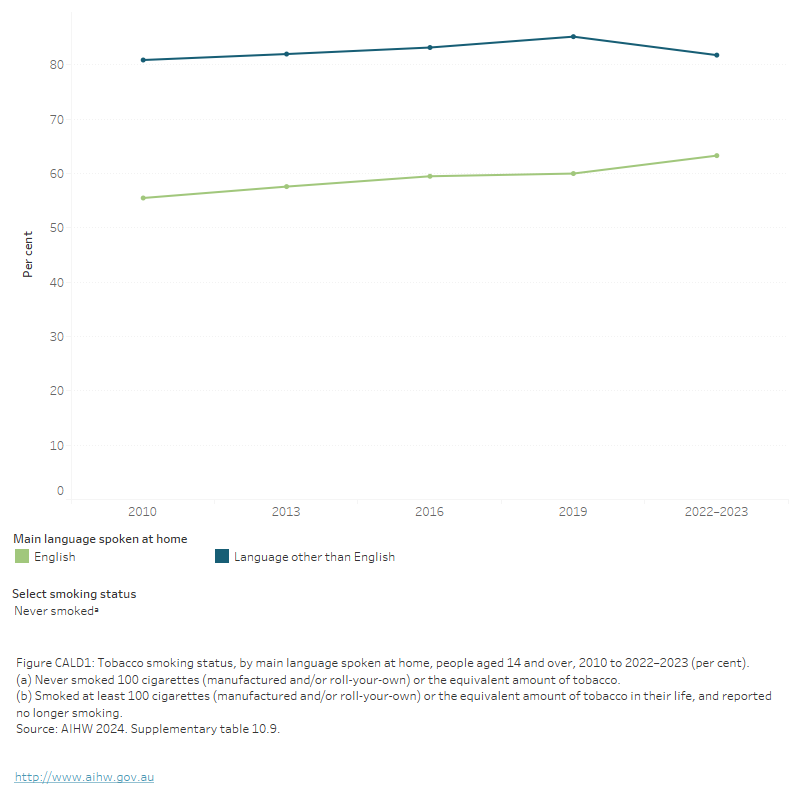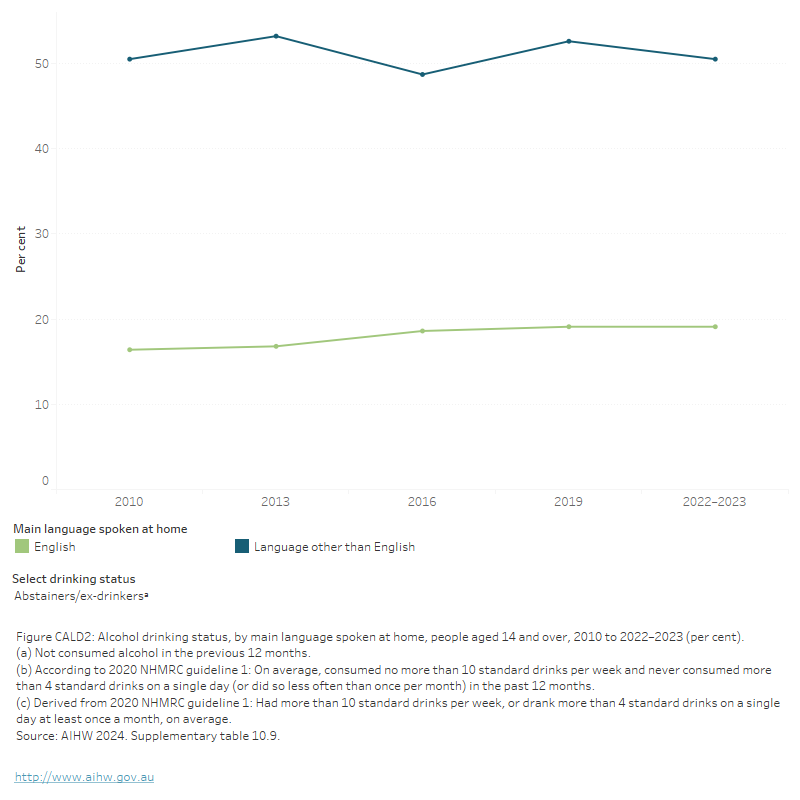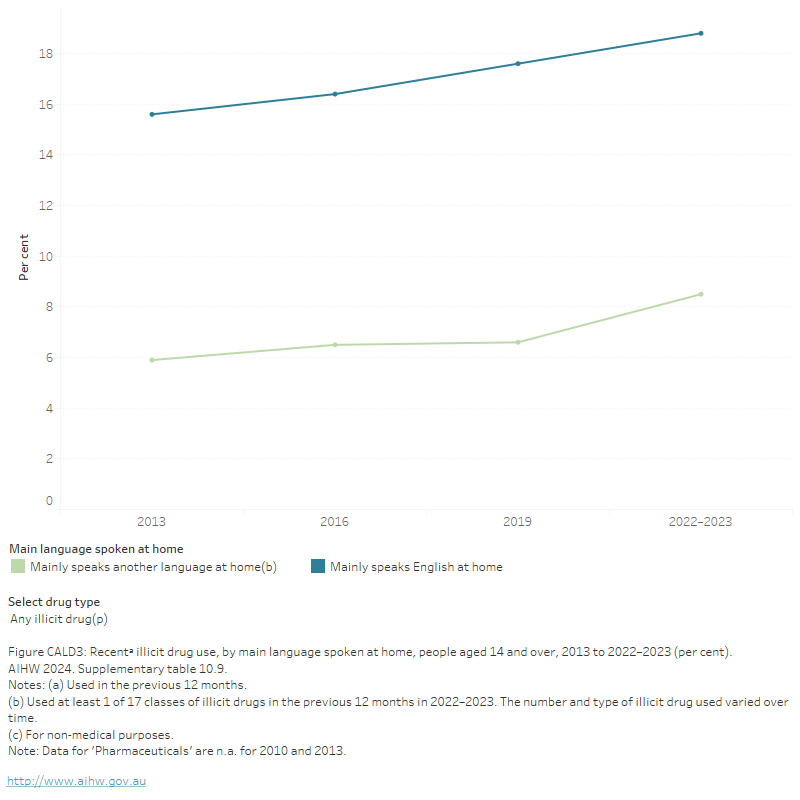People from culturally and linguistically diverse backgrounds
Key findings
View the people from CALD backgrounds fact sheet >
Australia has a large culturally and linguistically diverse (CALD) population. As of June 2021, 28% of Australia’s population were born overseas and this has been increasing over time (ABS 2022a). In 2021, there were over 400 separately identified languages spoken in Australian homes and 23% of Australians spoke a language other than English (ABS 2022b). For the purposes of this report, people from CALD backgrounds refers to people whose main language spoken at home is not English or who were born overseas (AIHW 2024a). For more information refer to Box CALD 1.
Some people from CALD backgrounds are more vulnerable to alcohol and other drug use due to a history of torture, trauma, grief and loss. This can also be exacerbated by family stressors, unemployment, language barriers, and lack of awareness of culturally appropriate services available (Department of Health 2017).
Box CALD 1: Alcohol and other drug data in CALD populations
There is a lack of publicly available and comprehensive data examining the use of alcohol and other drugs by people from CALD backgrounds. The Australian Institute of Health and Welfare (AIHW)’s National Drug Strategy Household Survey (NDSHS) is one of the only national data sources that specifically disaggregates alcohol and other drug use by main language spoken at home. CALD data from the NDSHS refers to people who indicated that English was not the main language spoken at home or who were born overseas.
The Alcohol and Other Drug Treatment Services National Minimum Data Set (AODTS NMDS) also collects CALD data, however this is based on information on clients’ country of birth instead of main language spoken at home. Over 1 in 10 clients (14%) who received treatment for their own or someone else’s alcohol or other drug use in 2022–23 were born outside of Australia (AIHW 2024a).
Data from the NDSHS indicate that people from CALD backgrounds are less likely to consume alcohol and other drugs compared with those whose main language spoken at home is English (AIHW 2024b).
Tobacco smoking
While there has been an increase between 2019 and 2022–2023 in the proportion of people across Australia reporting never smoking, the proportion of people who have never smoked is greater for people from CALD backgrounds (82%) compared with people who mainly speak English at home (63%) (AIHW 2024, Table 10.9). This has been the case since 2010. People from CALD backgrounds also continue to be less likely to smoke daily than people who mainly speak English (AIHW 2024).
NDSHS estimates indicate that there was a significant reduction in daily smoking among primary English speakers from 11.6% in 2019 to 8.5% in 2022–2023. For people who primarily speak another language, this figure fell from 5.3% in 2019 to 4.6% in 2022–2023 (AIHW 2024, Table 10.9; Figure CALD 1).
People from CALD backgrounds who do smoke tend to smoke fewer cigarettes than primary English speakers. In 2022–2023, among people who currently smoke, people who mainly spoke a language other than English smoked an average of 71 cigarettes per week, compared with 89 cigarettes for people who mainly spoke English (AIHW 2024, Table 0.9).
FIGURE CALD 1: Tobacco smoking status, by main language spoken at home, people aged 14 and over, 2010 to 2022–2023 (per cent)
The figure shows that, among people who mainly speak English at home, the proportion who smoked daily decreased from 15.8% in 2010 to 11.8% in 2019. Among people who mainly speak a language other than English, the proportion who smoked daily significantly declined from 11.4% in 2013 to 6.2% in 2019.

View data tables >
Alcohol consumption
New Australian guidelines to reduce health risks from drinking alcohol were released in December 2020.
Similar to smoking, data from the NDSHS show that people from CALD backgrounds are more likely to abstain from alcohol than people who mostly speak English (AIHW 2024). Over half (51%) of people who mainly spoke a language other than English were abstainers or ex-drinkers, compared with 19.1% of primary English speakers (AIHW 2024, Table 10.9). Additionally, in 2022–2023:
- people who mainly spoke a language other than English (11.8%) were much less likely to exceed risk guidelines for alcohol, compared with people who mainly spoke English at home (33%) (Figure CALD 2)
- less than 1 in 10 (8.5%) people from CALD backgrounds reported drinking more than 10 standard drinks of alcohol per week, compared with 27% for people who mainly spoke English at home (AIHW 2024, Table 10.9).
FIGURE CALD 2: Alcohol drinking status, by main language spoken at home, people aged 14 and over, 2010 to 2022–2023 (per cent)
The figure shows that, among people who mainly speak English at home, the proportion who exceeded the lifetime risk for alcohol use was lower in 2019 (18.8%) than in 2010 (22.3%). Among people who mainly speak a language other than English at home, the proportion remained relatively stable from 5.2% in 2010 to 3.8% in 2019.

View data tables >
Illicit drugs
In 2022–2023, recent illicit drug use continued to be less common among people from CALD backgrounds than those from English speaking backgrounds (AIHW 2024).
The 2022–2023 showed that:
- people from CALD background were less likely to have recently used illicit drugs (8.5%) than those who mainly speak English at home (18.8%)
- cannabis (4.8%) was the most commonly used illicit drug among people who mainly spoke a language other than English at home, followed by non-medical use of pharmaceuticals (2.8%). These proportions were much lower than for people who mainly spoke English at home (12.3% for cannabis and 5.4% for pharmaceuticals)
- use of other drugs was uncommon among people from CALD backgrounds (AIHW 2020) (AIHW 2024, Table 10.9; Figure CALD 3).
FIGURE CALD 3: Recentᵃ illicit drug use, by main language spoken at home, people aged 14 and over, 2010 to 2022–2023 (per cent)
The figure shows that the proportion of people who speak mainly English at home who had used any illicit drug within the past 12 months was slightly higher in 2019 (18.7%) than in 2010 (15.7%). Among people who mainly spoke a language other than English at home, illicit drug use has remained relatively stable from 2010 (7.0%) to 2019 (6.4%).

View data tables >
Treatment
The Alcohol and Other Drug Treatment Services National Minimum Data Set (AODTS NMDS) provides information on treatment provided to clients by publicly funded AOD treatment services, including government and non-government organisations. Data collected for the AODTS NMDS are released twice each year, via an early insights report in April and a detailed annual report mid-year. The early insights report does not include data on country of birth.
The Alcohol and Other Drug Treatment Services National Minimum Data Set (AODTS NMDS) provides information on treatment provided to clients by publicly funded AOD treatment services, including government and non-government organisations.
The latest Alcohol and other drug treatment services in Australia annual report shows that 13% of clients receiving treatment for their own alcohol and other drug use in 2022–23 were born outside of Australia (AIHW 2024a, Table SC.28). The United Kingdom (2.3%) and New Zealand (2.2%) were the most common countries of birth for these clients (AIHW 2024a). Comparatively, in 2021, 4.5% of the Australian population was born in the United Kingdom and 2.1% in New Zealand (ABS 2022b).
ABS (Australian Bureau of Statistics (2022a) Cultural diversity of Australia, ABS Website, accessed 4 March 2024.
ABS (2022b) Cultural diversity: Census 2021, ABS Website, accessed 15 July 2022.
AIHW (Australian Institute of Health and Welfare) (2024a) Alcohol and other drug treatment services in Australia annual report, AIHW, Australian Government, accessed 14 June 2024.
AIHW (2024b) National Drug Strategy Household Survey 2022–2023, AIHW, Australian Government, accessed 04 March 2024.
DoH (Department of Health) (2017) National Drug Strategy 2017–2026. Canberra: Department of Health, accessed 26 June 2024.


